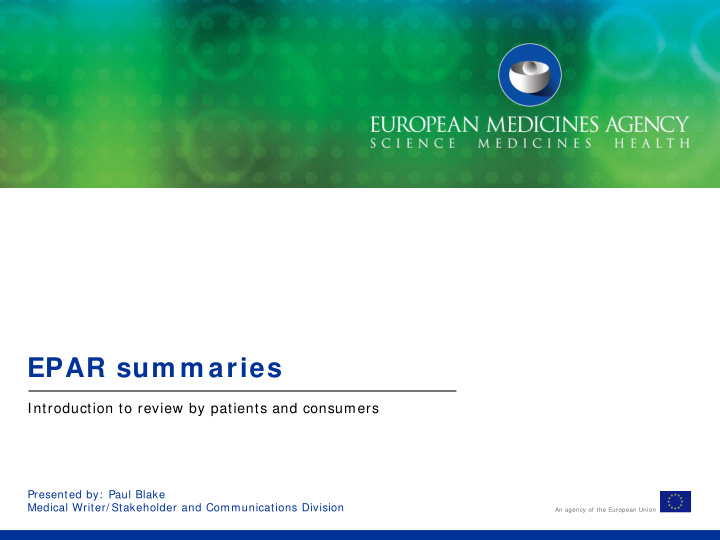



EPAR sum m aries Introduction to review by patients and consumers Presented by: Paul Blake Medical Writer/ Stakeholder and Communications Division An agency of the European Union
What are EPAR summaries? • Every centrally authorised medicine has its own page on the EMA website. • The EPAR summary is the first thing you see when you look up a medicine: http: / / www.ema.europa. eu/ ema/ EPAR summaries, PCO training session 10 December 2013
What are EPAR summaries? • Each centrally authorised medicine has an EPAR, including: – product information – Assessment Report by the Committee for Medicinal Products for Human Use (CHMP) • Summary is a short public-friendly document based on these, explaining the medicine and how it came to be approved • Required by EU law (but the form isn’t specified by legislation) • Not a replacement for the product information (which includes SmPC and patient leaflet) • A living document, which is kept updated throughout the lifecycle of the medicine EPAR summaries, PCO training session 10 December 2013
Content of EPAR summaries • What is the medicine and what is it used for? • How is it used • How does it work? • What benefits have been seen in studies? • What are the risks? • Why has it been approved? • What measures are being taken to ensure its safe and effective use? EPAR summaries, PCO training session 10 December 2013
How EPAR summaries are prepared • Documents – Product information – Adopted CHMP Assessment Reports – Internal style guide – Glossary of medical terms EPAR summaries, PCO training session 10 December 2013
The review process • Medical writers • EMA product team • Patient and consumer organisations • Rapporteur and CoRapporteur (assessors) • Company EPAR summaries, PCO training session 10 December 2013
Why the review by patient and consumers? • Patient/ consumer perspective • Patients and public concerns • Only review without source documents • Appropriate use of language • Quality check EPAR summaries, PCO training session 10 December 2013
Things to look out for • Complicated/ oversimplified language • Unexplained scientific terms • Inappropriate explanations • Unnecessary/ missing information • Confusing numbers • Do you understand the main benefits? • Do you understand basis for approval? EPAR summaries, PCO training session 10 December 2013
Comments from patients and consumers • All comments are considered • Write what you think/ feel • Comments can be in any form: – General or specific – Text changes (tracked) – Suggestions – Questions EPAR summaries, PCO training session 10 December 2013
Impact of review • Around half of comments estimated to lead to text changes (not less than other reviews) • Many implemented with modifications • Some may not be implemented immediately but are used for changing templates and standard definitions EPAR summaries, PCO training session 10 December 2013
Feedback to reviewers from patients and consumers EPAR summaries, PCO training session 10 December 2013
Feedback to reviewers from patients and consumers EPAR summaries, PCO training session 10 December 2013
Feedback to reviewers from patients and consumers EPAR summaries, PCO training session 10 December 2013
Feedback to reviewers from patients and consumers EPAR summaries, PCO training session 10 December 2013
Feedback to reviewers from patients and consumers EPAR summaries, PCO training session 10 December 2013
Feedback to reviewers from patients and consumers EPAR summaries, PCO training session 10 December 2013
Feedback to reviewers from patients and consumers EPAR summaries, PCO training session 10 December 2013
Conclusion • Patients & consumers review an essential part of the process • Aims include checking clarity, use of language • Reviewers from patient & consumer organisations provide unique perspectives that improve the final document EPAR summaries, PCO training session 10 December 2013
Recommend
More recommend